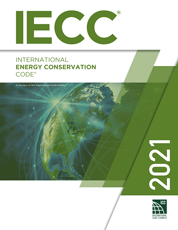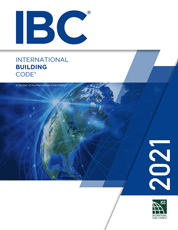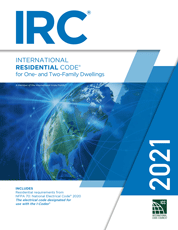INTERNATIONAL ENERGY CONSERVATION CODE (2021 IECC) PLAN CHECK
Commercial Buildings Energy Efficiency [CE] Download PDF of CE Plan Review Checklist
COMMERCIAL BUILDING: For this code, all buildings that are not included in the definition of “residential building.” (see below)
Determine compliance option (Tab A or Tab B) used for the submitted plan and then verify plan compliance based on requirements for the identified compliance option. Refer to Tab C for resources to help facilitate effective plan checking and inspections.
The Prescriptive Compliance option requires compliance with Sections C402 through C406 and Section C408. Dwelling units and sleeping unites in Group R-2 buildings without systems serving multiple units shall be deemed to be in compliance with this chapter, provided they comply with Section R406.
1. Per Section C402.1 (Item 1), check and follow the applicable prescriptive compliance option used for the opaque portions of the proposed building thermal envelope shown on the submitted construction plan (see Section C103 Construction Documents):
- C402.1.3 Insulation R-value Approach - Verify compliance with insulation R-values of Table C402.1.2 based on building type (Group R or All Other) and Climate Zone for the specified construction type and insulation method.
- Pass
- Fail
- More information required
- C402.1.4 Assembly U-factor Approach – Verify compliance with U-factors of Table C402.1.3 using methods consistent with ASHRAE 90.1 Appendix A or other approved methods appropriate for the assembly type and insulation method proposed. Request documentation and needed to verify compliance.
- Pass
- Fail
- More information required
- C402.1.5 Component Performance Approach – Verify envelope assembly trade-offs (if any) comply with calculations and requirements of Section C402.1.5 by adequate documentation of analysis and comparison to measures shown on submitted construction plans for building envelope (see Section C103 Construction Documents). Generally, a COMcheck analysis and report (or similar) provides means for verification.
- Pass
- Fail
- More information required
[Note: Section C303.1 gives the code official authority to evaluate any material, system, or component to determine if it is identified “in a manner that will allow a determination of compliance with the applicable provisions of this code.” For evaluation of material R-values where the basis is questionable, refer to this Quick Guide: R-value Compliance Determinations.]
2. Per Section C402.1 (Item 2), verify roof solar reflectance and emittance comply with Section C402.3 (Climate Zones 0 through 3 only) Pass Fail
3. Per Section C402.1 (Item 3), verify that specified fenestration as shown on construction documents complies with Section C402.4 including fenestration area limits (also see Section C303.1.3 Fenestration product rating). Pass Fail
[Note: If Section C402.1.5 is used for prescriptive compliance for the overall building thermal envelope, fenestration should be addressed in that method and may vary from requirements in Section C402.4.]
4. Per Section C402.1 (Item 4), verify that air leakage of building complies with Section C402.5 following either prescriptive air barrier construction requirements or whole building air leakage testing where required based on building type and size, as applicable to the climate zone and submitted construction documents. Pass Fail
[Note: If testing is used as the optional or required basis of compliance verify compliant testing is indicated on the construction documents and verify results when completed later in the construction process.]
5. Verify compliance with Section C403 Building Mechanical Systems, including submitted heating and cooling load calculations, ventilation, equipment efficiencies, and equipment sizing. Pass Fail
6. Verify compliance with Section C404 Service Water Heating, including equipment performance, insulation of piping, supply piping, and others as applicable. Pass Fail
7. Verify compliance with Section C405 Electrical Power and Lighting Systems, including lighting efficacy, controls, daylighting, lighting power requirements and allowances, metering, transformers, elevators and escalators, wiring (conductor) voltage drop, automatic receptacle control, and energy monitoring for buildings with condition floor area of 25,000 sqft or greater. Pass Fail
8. Verify compliance with Section C406 Additional Efficiency Requirements with one or more of the 11 additional efficiency measures included on plan to achieve at least 10 credits. Pass Fail
9. Verify compliance with Section 408 Maintenance Information and System Commissioning, including provision of building operations and maintenance information, manuals, and reports as required within 90 days of data of receipt of certificate of occupancy. Pass Fail
10. Verify compliance with Section C401.3 Thermal Envelope Certificate by a permanent certificate installed in the building indicating all of the listed energy efficiency measures employed in compliance with the code and the approved construction documents. Pass Fail
[Note: Verification activities 9 and 10 occur near the end of the construction project and should be verified prior to occupancy.]
The Total Building Performance option requires compliance with Section C407.
Refer to Section C407 and submitted whole building simulation documentation (Section C407.3) to determine plan compliance with the proposed design as modeled. At a minimum:
- Verify modeling software tool used for compliance meets requirements of Section C407.5 as addressed in submitted documentation (Section C407.3).
- Verify that mandatory requirements of the table in Section C407.2 have been satisfied by the modeling documents and included on the proposed construction plans and that the reported energy cost of proposed design is not greater than 80% [85% is an error in first printing corrected by errata] of the energy cost of the standard reference design.
- Verify that the submitted construction plan contains measures and features consistent with the proposed design as described in the submitted documentation per Section C407.3.
- Where the building does not comply with prescriptive requirements (see Tab A), verify that required performance is provided by other means (e.g., improved HVAC efficiency, improved lighting, improved air leakage control, improved building thermal envelope, or other measures as applicable).
- For a list of information required on construction documents, unless modified by local administrative provisions, refer to Section C103.2 Information on construction documents.
- For required building department inspections, unless modified by local administrative provisions, refer to Section C105.2 Required inspections. Refer also to Section C303.2 and Section C402.2 for installation requirements.
- Ci Tools:
- Ci Applications:
- Ci Code Reports & Listings:
- Ci Standard:
- ANSI/ABTG FS200.1 – 2022 "Standard for Use of Foam Plastic Insulating Sheathing (FPIS) in Building Envelopes: Above-grade Walls"
- Education:
- Plan check and inspection aids and checklists (examples):
- US Department of Energy (DOE) Building Energy Codes Program (BECP):
Residential Buildings Energy Efficiency [RE] Download PDF of RE Plan Review Checklist
RESIDENTIAL BUILDING: For this code, includes detached one- and two-family dwellings and multiple single-family dwellings (townhouses) and Group R-2, R-3 and R-4 buildings three stories or less in height above grade plane.
Determine compliance option (Tab A, Tab B, or Tab C) used for the submitted plan and then verify plan compliance based on requirements for the identified compliance option. Refer to Tab D for resources to help facilitate effective plan checking and inspections.
The Prescriptive Compliance Option requires compliance with Sections R401 through R404.
1. Per Section R402.1, check and follow the applicable prescriptive compliance option used for the opaque portions of the proposed building thermal envelope shown on the submitted construction plan (see Section R103 Construction Documents):
- R402.1.1 Vapor retarder – Verify that the wall assembly design and insulation strategy complies with the vapor retarder provisions of Section R702.7 of the International Residential Code (IRC). NOTE: For a free on-line tool to coordinate energy code insulation and building code vapor retarder compliance, refer to wall calculators.
- R402.1.2 Insulation and fenestration criteria – Verify compliance of opaque assemblies with U-factors of Table R402.1.2 and fenestration U-factor and SHGC based on product certification per Section R303.1.3. For proposed assembly U-factors, request documentation of measurements (test data), calculations, or an approved source as needed to verify compliance.
- Pass
- Fail
- More information required
- R402.1.3 R-value Alternative - Verify compliance with insulation R-value options of Table R402.1.3 for the applicable Climate Zone. These are pre-determined alternatives that comply with the required U-factors of Section R402.1.2. Also, verify that the R-value provided for cavity and continuous insulation components comply with Section R402.1.4 R-value computation. NOTE: For a free on-line tool to determine wall assembly R-value and U-factor compliance, refer to wall calculators.
- Pass
- Fail
- More information required
- R402.1.5 – Total UA alternative – verify envelope assembly trade-offs (if used) comply with calculations and requirements of Section R402.1.5 by adequate documentation of analysis and comparison to measures shown on submitted construction plans for building envelope (see Section R103 Construction Documents). Generally, a REScheck analysis and report (or similar) provides means for verification.
- Pass
- Fail
- More information required
[Note: Section R303.1 gives the code official authority to evaluate any material, system, or component to determine if it is identified “in a manner that will allow a determination of compliance with the applicable provisions of this code”. For evaluation of material R-values where the basis is questionable, refer to this Quick Guide: R-value Compliance Determinations.]
2. Verify that specified fenestration, including glazed fenestration, opaque doors, and sunrooms, comply with Section R402.3. Pass Fail
[Note: If Section R402.1.5 is used for prescriptive compliance of the overall building thermal envelope, fenestration should be addressed in that method and may vary from requirements in Section R402.1.2 and Section R402.3, but must not exceed the maximum area weighted U-factor and SHGC per Section R402.5.]
3. Verify that air leakage of the building complies with Section R402.4 following prescriptive air barrier construction requirements and by whole building air leakage testing. Pass Fail
[Note: Verify whole building air leakage (blower door) test results comply with maximum air leakage limits when completed later in the construction process.]
4. Verify compliance with Section R403 Systems, including controls such as a programmable thermostat, ductwork location and air leakage sealing and testing, piping insulation, hot water systems, mechanical ventilation, equipment sizing and efficiency, and others as applicable. Pass Fail
5. Verify compliance with Section R404 Electric Power and Lighting Systems, including use of high-efficacy lighting sources and lighting controls. Pass Fail
6. Verify compliance with Section R408 Additional Efficiency Package Options with use of one of the five additional efficiency package options of Section R408.2. Pass Fail
7. Verify compliance with Section R401.3 by a permanent certificate installed in the building indicating all of the listed energy efficiency measures employed in compliance with the code and the approved construction documents. Pass Fail
The Total Building Performance Option requires compliance with Section R405.
Refer to Section R405 and submitted whole building simulation documentation (Section R405.3) to determine plan compliance with the proposed design as modeled. At a minimum:
- Verify modeling software tool used for compliance meets requirements of Section R405.3.1 and Section R405.5 as include with a submitted compliance report in accordance with Section R405.3.
- Verify that mandatory requirements of the table in Section R405.2 have been satisfied by the modeling documents and included on the proposed construction plans and that the reported energy cost of proposed design is not greater than the energy cost of the standard reference design.
- Verify that the standard reference design (baseline for performance) and the proposed design comply with the requirements of Table R405.4.2(1) in Section R405.4, particularly in cases where the standard reference design is indicated to be the same as the proposed design.
- Verify that the submitted construction plan contains measures and features consistent with the proposed design as described in the submitted documentation per Section R405.3.
- Verify that the fenestration area-weighted U-factor and SHGC are not greater than the maximums permitted in Section R402.5.
- Where the building does not comply with prescriptive requirements (see Tab A), verify that required performance is provided by other means (e.g., improved thermal envelope, reduced air exchange rate, or other measures in Table R405.4.2(1) where the standard reference design is not required to match the proposed design).
The Energy Rating Index (ERI) Option requires compliance with Section R406.
Refer to Section R406 and submitted documentation of energy rating software tool and compliance report in accordance with Section R406.7 by an approved third party (e.g., a certified rater) in accordance with Section R406.6.
- Verify that the proposed rated design ERI score complies with the maximum ERI score of Table R406.5 for the applicable climate zone in accordance with Section R406.5.
[NOTE: A confirmed compliance report after completion of construction is required to obtain a certificate of occupancy in accordance with Section R406.7.2.2 and it also should include evidence that inspections were conducted to confirm that the rated design energy features were included and properly installed in the home.]
- Verify that the building thermal envelope complies with the requirements of Section R406.3 to address two cases: (1) where on-site renewable energy is not included or (2) where on-site renewable energy is included in the ERI score submitted to demonstrate compliance.
[NOTE: In the latter case, the building thermal envelope must be at least equivalent to prescriptive compliance in accordance with the 2015 IECC. In the former case, it must not be greater (worse) than 1.15 x UA of a prescriptively designed home per the 2021 IECC.]
- Verify that a renewable energy certificate (REC) is owned by or retired on behalf of the home owner per Section R406.7.3, or is conveyed to the owner by contract. Note that offsite renewable energy cannot be used as a means of compliance and should not be incorporated into an ERI score. These RECs, therefore, are not addressing a matter of energy code compliance but rather a market instrument related to the valuation of any installed onsite renewable energy attributes.
- Request additional documentation of the proposed rated design and reference design in accordance with Section R406.7.4 where needed to verify the completeness and accuracy of the design for compliance purposes and where not otherwise addressed in required compliance report of Section R406.7.2.
- For a list of information required on construction documents, unless modified by local administrative provisions, refer to Section R103.2 Information on construction documents.
- For required building department inspections, unless modified by local administrative provisions, refer to Section R105.2 Required inspections. Refer also to Section R303.2 and Section R402.2 for installation requirements.
- Ci Tools:
- Ci Applications:
- Ci Code Reports & Listings:
- Ci Standard:
- ANSI/ABTG FS200.1 – 2022 "Standard for Use of Foam Plastic Insulating Sheathing (FPIS) in Building Envelopes: Above-grade Walls"
- Education:
- Plan check and inspection aids and checklists (examples):
- US Department of Energy (DOE) Building Energy Codes Program (BECP):
INTERNATIONAL BUILDING CODE (2021 IBC) PLAN CHECK
- Building code provisions related to code-compliant applications of foam plastic insulating sheathing
- Standards referenced in the building code and related to foam plastic insulating sheathing materials and applications
- Code evaluation research reports and listings for code-compliant foam sheathing products
- Manufacturers with code compliant foam sheathing materials and technical support
INTERNATIONAL RESIDENTIAL CODE (2021 IRC) PLAN CHECK
- Building code provisions related to code-compliant applications of foam plastic insulating sheathing
- Standards referenced in the building code and related to foam plastic insulating sheathing materials and applications
- Code evaluation research reports and listings for code-compliant foam sheathing products
- Manufacturers with code compliant foam sheathing materials and technical support
Frequently-Asked Questions CI Resource Guide (2024 Codes) CI Resource Guide (2021 Codes)


